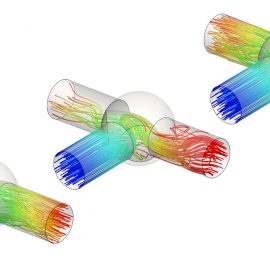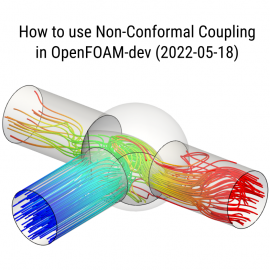In August 2022, CFD Direct introduced modular solvers to the OpenFOAM development version. Modular solvers are written as classes, in contrast to the traditional application solvers which have been integral to OpenFOAM since icoFoam in 1993. They are simpler to use, maintain and understand than application solvers. They are more flexible; in particular, modules for different fluids and solids can be coupled across multiple regions, e.g. for conjugate heat transfer (CHT) with multiphase flow. Modular solvers are deployed using the foamRun or foamMultiRun applications, which contain a generic solution algorithm for single and multiple regions, respectively. Additional modules and applications replace existing tools for data processing and case configuration.
Effective OpenFOAM Maintenance

OpenFOAM is the leading free, open source software for computational fluid dynamics (CFD), distributed by The OpenFOAM Foundation. In 2014, OpenFOAM had accumulated significant “technical debt” due to a drive for new functionality at the expense of maintenance. Facing an unsustainable level of technical debt, CFD Direct was founded to manage and develop OpenFOAM back to a sustainable position. Code repair has targeted niche functionality that receives less testing. Redesign of larger, critical components of OpenFOAM has eliminated clusters of issues. By 2022, CFD Direct has recovered most of the technical debt, making OpenFOAM significantly more robust, usable and extensible.
OpenFOAM Non-Conformal Coupling

In May 2022, CFD Direct released Non-Conformal Coupling (NCC) in OpenFOAM to connect regions of a domain with independent meshes for applications including rotating geometry. NCC is a robust replacement for the Arbitrary Mesh Interface (AMI) and associated ACMI and Repeat AMI functionalities. Unlike the AMI functionalities, NCC ensures conservation which is essential for accuracy but also for stability, in particular in numerical schemes designed to maintain boundedness, e.g. in multiphase flows. NCC naturally works for partially-overlapping geometries, as illustrated by the case of opening and closing of a three port ball value.
Using NCC in OpenFOAM

In May 2022, CFD Direct released Non-Conformal Coupling (NCC) in OpenFOAM to connect regions of a domain with independent meshes for applications including rotating geometry. NCC is a robust replacement for the Arbitrary Mesh Interface (AMI) and associated ACMI and Repeat AMI functionalities. This document describes how to use NCC to enable OpenFOAM users to transition from the AMI functionality to NCC. Due to its popularity, AMI remains in OpenFOAM for the next version 10 release in July 2022, but will thereafter be removed. The unreliable ACMI and Repeat AMI functionalities are removed.
CFD Direct Year 7: 2021-2022

In Year 7 of CFD Direct, our developments of OpenFOAM included a generalised load balancer for parallel running . We provided core maintenance, including standardisation of fluid properties, and repaired issues, e.g. to stablise multiphase simulations. We managed the OpenFOAM Foundation, releasing OpenFOAM v9, packaging OpenFOAM-dev and publishing websites and documentation. We produced our book , “Notes on Computational Fluid Dynamics: General Principles”, delivered 56 days of Live Virtual OpenFOAM Training, and provided cloud CFD with CFDDFC® to over 1000 subscribers.
CFD Book for OpenFOAM

CFD Direct is delighted to announce its publication of a book Notes on Computational Fluid Dynamics: General Principles. The book is written for people who use CFD in their work, research or study, providing essential knowledge to perform CFD analysis with confidence. It offers a modern perspective on CFD with the finite volume method, as implemented in OpenFOAM and other popular general-purpose CFD software. Fluid dynamics, turbulence (and RAS modelling) and boundary conditions are presented alongside the numerical methods and algorithms in a series of short, digestible notes.

